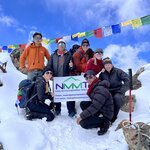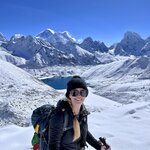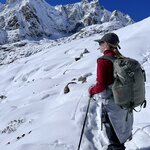
Gokyo Lakes Trek - 16 Days

Highlights
- Stand at the shores of a chain of six turquoise, glacial-fed lakes
- Hike along Ngozumpa Glacier, the largest glacier in the Himalaya
- Avoid the Everest crowds, but enjoy the selection of great views
- Climb Gokyo Ri (5,357 m) for spectacular views of Everest, Lhotse, and Cho Oyu
- Return via Renjo La pass (5,340 m), over one of Nepal's most beautiful passes
- Trek through the Sherpa town of Khumjung, home of a ‘real’ yeti skull
- From 'Scoundrel's viewpoint' near the fifth lake, peer over a wasteland of rock and ice that is the vast Ngozumpa Glacier
Overview
| Fast facts | |
|---|---|
| Duration | 16 days |
| Max. elevation | 5,400 m (Gokyo Ri) |
| Start/finish | Lukla/Lukla |
| Difficulty | Challenging |
| Best season | Spring/Fall |
| Accommodation | Teahouse |
As well as trekking to the six glacial-fed Gokyo Lakes, trekkers can include a climb to the top of Gokyo Ri, which is at the same altitude as Everest Base Camp. From the summit, you will enjoy spectacular views of Everest and other very high mountains and glaciers.
Trekking this route provides a lot of variety: views of the bright turquoise high-altitude lakes, Ngozumpa glacier (the largest glacier in the Himalayas), and views across to Everest as well as other 8,000 meter-plus mountains from the top of Gokyo Ri (Lhotse, Makalu, and Cho Oyu).
Interested in doing this trek? Get in touch with one of our local Nepal specialists who can organize this trek for you with an experienced licensed guide. Connect with a local specialist
Brief Itinerary
Below, you'll find our itinerary from trekking from Lukla to Gokyo and back to Lukla. (Extra days can be added if trekking to Jiri/Lukla if visiting more lakes.)
| Day | Destination | Duration | Overnight |
|---|---|---|---|
| Day 1 | Welcome to Kathmandu! | Kathmandu | |
| Day 2 | Explore Kathmandu | Kathmandu | |
| Day 3 | Fly to Lukla; Trek to Phakding (8,563 feet/ 2,610 m) | 4 hours | Phakding |
| Day 4 | Namche Bazaar (11,290 feet / 3,440 m) | 5 hours | Namche Bazaar |
| Day 5 | Namche Bazaar (day-hike to Khumjung) | Rest day | Namche Bazaar |
| Day 6 | Trek from Namche Bazaar to Dole (4,200 m) | 5 hours | Dole |
| Day 7 | Trek from Dole to Machhermo (4,470 m) | 3 hours | Machhermo |
| Day 8 | Trek from Machhermo to Gokyo | Rest day | Machhermo |
| Day 9 | Acclimatization in Gokyo (4,790 m); Climb Gokyo Ri or visit Gokyo Lakes | 6 hours | Gokyo |
| Day 10 | Gokyo village (day-hike to Fifth Lake, 4,956 m) | 7 hours | Gokyo |
| Day 11 | Trek from Gokyo to Phanga (early morning summit of Gokyo Ri, 5,400 m) | 7 hours | Phanga |
| Day 12 | Trek to Khumjung | 6 hours | Khumjung |
| Day 13 | Trek from Khumjung to Namche Bazaar | 1.5 hours | Namche Bazaar |
| Day 14 | Trek from Namche Bazaar to Phakding | 4 hours | Phakding |
| Day 15 | Trek from Phakding to Lukla | 4 hours | Lukla |
| Day 16 | Fly back to Kathmandu; Depart | 30 minutes |
Best Season
As with most treks in Nepal, the best times to do it are spring (March-May) and autumn (September-November). In these months the weather is likely to be clear, and daytime temperatures warm. The Khumbu region, however, is known to be particularly cold and dry, and many trekkers develop the ‘Khumbu cough’ due to the dry dust.
It is usually possible to trek in the summer/monsoon and winter seasons, but greater preparation for difficult conditions is required, and you may not get clear views.
For more information, check out our article on the best time to visit Nepal.




Chat with a local specialist who can help organize your trip.
Getting There & Away
As the first part of the trek follows the same route at the Everest Base Camp trek, the most common way of getting onto the trail is to fly to the small airport at Lukla. This is a stunning experience in itself. Numerous flights are made daily from Kathmandu, in small fixed-wing airplanes, taking around 30 minutes. However, bad weather frequently closes the airport, so it’s wise to prepare for delays if flying to Lukla and to keep a day or two as buffer days.
The alternative to flying to Lukla is to trek overland from outside Kathmandu, the “pioneers’ route” that was taken by expeditioners to Everest in the 1950s. This connects to the trailhead at Jiri, which passes beneath Lukla. Taking this option significantly lengthens the trek, adding about an extra seven days. It also requires crossing several passes, including one of over 3,500 meters. This is not the ‘easy’ option of getting onto the Gokyo Lakes trail, but it is adventurous and will help with acclimatization.
The Gokyo Lakes trek is in-and-out, meaning that you retrace your route back once you’ve finished.




Accommodation & Meals
Like elsewhere in the Khumbu region, teahouses on the Gokyo Lakes trek are well-developed and relatively comfortable. There is a lot of variety in this region, from ultra-budget to hotels of a quality that you could find in Nepal’s cities, with hot showers and electric blankets on the beds. However, not all grades of accommodation may be available in all settlements, particularly the smaller ones.
The food will also be good, with items such as rice and curry, noodles, momos, soup and Tibetan-style bread featuring on menus. A staple food in the Khumbu region are potatoes, and these feature more prominently on the menus of trekking lodges here than elsewhere in Nepal, with fewer other fresh vegetables. The amount of fresh food available will decline as you progress higher, and costs also rise.
Permits & Regulations
The Sagarmatha National Park (through which you'll be trekking), is a UNESCO World Heritage site. As with all treks in this park, you’ll need a TIMS and Sagarmatha National Park permit.
- TIMS permit: $10 USD per person
- Sagarmatha National Park permit: $30 USD per person
If you’re organizing your trek through a trekking agency, they will arrange these for you. If you’re arranging the trek yourself, you’ll need to pick up your TIMS permit in Kathmandu and your Sagarmatha National Park permit in Monjo.
Difficulty
This trek is generally considered ‘moderate’ for a trek of this length at high altitude. If trekking a route that ascends Gokyo Ri, the highest altitude that will be reached is the summit, at around 5,400 meters. The summit of Gokyo Ri is itself at around the same altitude as Everest Base Camp, making this trek generally easier in terms of altitude. You won’t be sleeping at this height at any point along the trek though, and there are fewer nights spent above 4000 meters than the Everest Base Camp trek, making it less problematic in terms of potential altitude-related problems.
Variations
Return to Lukla via Renjo La

Instead of returning back the same way to Namche Bazaar, take the Renjo La pass (west, just above Gokyo village) and descend down into a beautiful valley that eventually leads back to Namche Bazaar, where you follow the normal route back to Lukla. This route is much less trodden and takes you through the beautiful Sherpa villages of Thame and Thamo.
Combine with Everest Base Camp - 18 Days

You can also extend your trek by crossing over Cho La pass (to the east) and connecting with the popular Everest Base Camp trek. From Gokyo village, you'll immediately cross the Ngozumpa glacier and then make a steep climb up the pass, before descending down to join the Everest Base Camp trail.
Complete all "Three Passes" - 21 Days

The Gokyo Lakes trek can also be combined with the Three Passes trek. Crossing the second of the three passes (counter-clockwise), Cho La, takes you to Gokyo village. From there you can climb Gokyo Ri, continue on to the upper lakes, and/or follow the Gokyo Lakes route on your return journey to Lukla. If you want to combine these treks, it is recommended that you start on the Three Passes trek and join the Gokyo Lakes trek, rather than the other way around, due to the altitudes and acclimatization.
Request a Custom Itinerary
Have one of our local specialists in Nepal put together a custom itinerary that's unique to your interests and time frame. To start organizing a custom tour, click here to get started.






